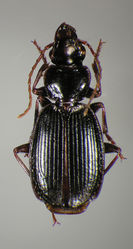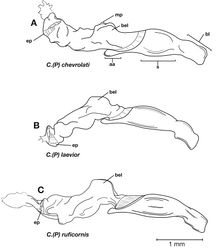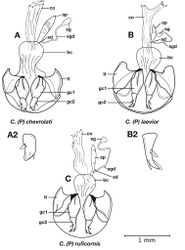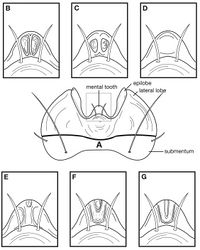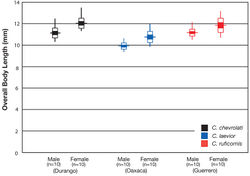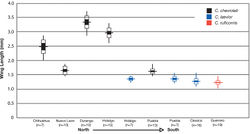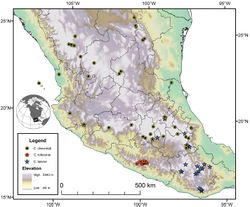Cymindis laevior
| Notice: | This page is derived from the original publication listed below, whose author(s) should always be credited. Further contributors may edit and improve the content of this page and, consequently, need to be credited as well (see page history). Any assessment of factual correctness requires a careful review of the original article as well as of subsequent contributions.
If you are uncertain whether your planned contribution is correct or not, we suggest that you use the associated discussion page instead of editing the page directly. This page should be cited as follows (rationale):
Citation formats to copy and paste
BibTeX: @article{Hunting2013ZooKeys259, RIS/ Endnote: TY - JOUR Wikipedia/ Citizendium: <ref name="Hunting2013ZooKeys259">{{Citation See also the citation download page at the journal. |
Ordo: Coleoptera
Familia: Carabidae
Genus: Cymindis
Name
Cymindis laevior (Bates) stat. n. – Wikispecies link – Pensoft Profile
- Pinacodera atrata var. laevior Bates 1891[1]:270. TYPE MATERIAL: 7 specimens. LECTOTYPE: male, here selected, labeled: “Type/ HT” [circular, ringed with red]”; “Huitzo/ Oaxaca/ Höge; “Tr. Ent. S. L., 1891/ Pinacodera/atrata, Chevr./v. laevior/Bates [handwritten]”; “1891-64”; Pinacodera/ atrata var./ laevior/ Bates” [handwritten]; [BMNH]. TYPE LOCALITY: Huitzo, Oaxaca, Mexico.
Diagnosis
Adults of Cymindis laevior (Fig. 32) are distinguishable from those of other species of the chevrolati complex through a combination of a glabrous dorsal surface and genitalic characters: males without a microtrichial patch on the basal endophallic lobe (bel) of the aedeagus (Fig. 34B) and female gonocoxite 2 (gc2) long and narrow (Fig. 35B).
Description
With character states of subgenus Pinacodera and chevrolati complex restricted as follows: OBL 9.33 – 12.00 mm. Length (n= 10 males, 10 females): head 0.92 – 1.04, pronotum 1.80 – 2.28, elytra 4.83 – 6.25, metepisternum 0.86 – 1.1 mm; width: head 1.80 – 2.24, pronotum 2.20 – 3.04, elytra 3.67 – 4.75, metepisternum 0.60 – 0.66 mm.
Body proportions. HW/HL 1.92 – 2.33; PWM/PL 1.18 – 1.35; EL/EW 1.27 – 1.45; ML/MW 1.40 – 1.67.
Color (Fig. 32). Dorsum of head black to rufo-piceous; legs rufo- piceous.
Microsculpture. Elytra with mesh pattern isodiametric, microlines shallow throughout length.
Macrosculpture and pilosity. Dorsal punctures with setae present, very short, hardly visible at 50×. Head ventrally with sparse, scattered setigerous punctures from behind eye laterally toward mentum. Pronotum normally with relatively evenly scattered setigerous punctures throughout, more densely so toward margins; few specimens with setigerous punctures along margin and few to no punctures on disc. Elytral epipleuron glabrous.
Fixed setae. Pronotum with two setae along each margin. Four to six setae (typically four) along apical margin of sternum VII (Fig. 3).
Luster. Elytra glossy throughout.
Head (Fig. 37E-G). Mental tooth form varied.
Hind wings. Markedly reduced, 1.06–1.57 mm in length, mean 1.32 mm.
Male genitalia. Phallus (Fig. 34B) length 2.40–2.60 mm.
Female genitalia. Gonocoxite 2 (gc2) (Fig. 35B) long and narrow.
Collection notes and habitat
The known elevational range of Cymindis laevior extends from 1524 to 3400 m. Specimens have been collected under bark, in woody debris and in leaf litter associated with forests of oak, pine, alder, juniper and stands of yucca. They have also been collected from bromeliads growing on standing trees. Because adults are incapable of flight, their presence above ground indicates the ability to climb trees.
Geographical distribution
(Fig. 41) The range of this species is restricted to Mexico, extending from northern Hidalgo in the eastern Transvolcanic Sierra east to western Veracruz and west to eastern Jalisco. The range extends in the Sierra Madre del Sur southward through the Sierra Madre de Oaxaca south to the Sierra de Miahuatlan from southern Oaxaca, and as far west as western Oaxaca.
Evolutionary affinities. Based on genitalic characteristics and wing length states, I postulate that Cymindis laevior is the closest relative of Cymindis ruficornis.
Chorological affinities. Cymindis laevior is sympatric in the northern most portion of its range with Cymindis chevrolati (Fig. 41).
Material examined. I have examined 202 specimens; 34 males and 20 females dissected. For details see University of Alberta Strickland Virtual Entomology Museum Database (University of Alberta 2009[2]).
Taxon Treatment
- Hunting, W; 2013: A taxonomic revision of the Cymindis (Pinacodera) limbata species group (Coleoptera, Carabidae, Lebiini), including description of a new species from Florida, U.S.A. ZooKeys, 259: 1-73. doi
Other References
- ↑ Bates H (1891) Additions to the carabideous fauna of Mexico, with remarks on some of the species already recorded. Transactions of the Entomological Society of London 1891, 223–278, illus.
- ↑ University of Alberta (2009) E. H. Strickland Virtual Entomology museum Database. Retrieved August 25, 2009, Web site: http://www.entomology.museums.ualberta.ca/
Images
|

